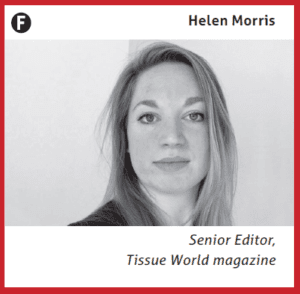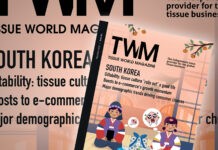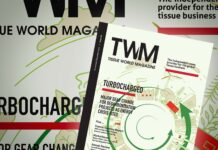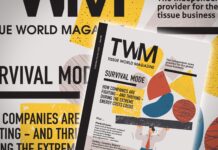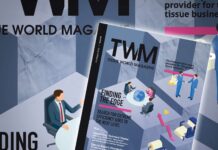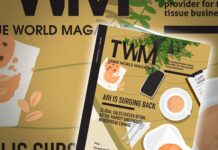This edition of TWM captures the distinct sense of momentum and energy, and change, at this point in tissue’s long history. These pages will give readers a comprehensive cross-analysis of those dynamics. We major on pulp – the single most important cost issue facing tissue today and the subject of much concerned speculation for some years. In our Pulp Technical Theme, Metsä Fibre explains its ambitious development project at its Finnish bioproduct mill, where runnability and key fibre quality softwood pulp makes for optimal production process. The right fibres, how they are treated, and the quest for the optimal fibre furnish are under the spotlight by UPM Pulp, which over the last few years has expanded its production intensively.
And Södra Cell explains how it won a Best Sustainability Project award for its marketing campaign to communicate that products from sustainably-managed forests are a good thing for the consumer and for the environment.
And, crucially, management consultants Pöyry analyse the complexities which comprise the pulp price, currently at a record high, and suggest that there are indications that prices are finally levelling out.
On that issue, Sofidel’s Luigi Lazzareschi thinks we have a year or two to wait yet…
A change is going to come for the US
In a wide-ranging interview, the CEO examines the influences behind the price of pulp (see this issue’s Marketissues).He also addresses the effects of tariffs, in general terms, but also specifically on the Pacific rim region of the American north west.
He was speaking to TWM after the Italian tissue giant’s official opening of its ultramodern mill – it’s a mile long, cost $400m on a 280-acre plant in Circleville, Ohio.
The mill is a big statement by Sofidel towards another issue facing the US … its ageing machinery. Lazzareschi: “I believe an investment like Circleville will really change the way tissue mills are producing in the USA. The market has been very concentrated and in the hands of just a few big tissue players producing branded products, and so there hasn’t been much investment in new technology… because they dominated the market.
“Now the American private label market is growing very quickly, and it is very competitive. I believe there will soon be a big push by the tissue manufacturers to renew their assets.”
Elsewhere for our Country Report: China, one clear advantage in the Chinese market is its rapid expansion of up-to-date technology. Two companies – Hengan Group and Hebei Jinboshi Group – make clear the ‘consumer battlefield’ and sense of tissue’s expanding reach towards that famed and as-yet unreached market.
They have a lot to say about integrated plants, tariffs and what they are doing about them, the price war, overcapacity, pulp … but the over-riding impression is of consumers with more money on their credit cards
demanding more quality, variety, better hygiene products, enjoying ‘home tourism’ and boosting AfH. Thus, medium and highend products are now becoming successful in third- and fourth-tier cities and rural markets as urbanisation continues a pace.
In all this growth there is occasionally a surprising cultural shift… like young Chinese going off the idea of home cooking, resulting in a fall in use of the mighty kitchen towel.
Looking back, and forward a year
We borrowed the quote at the top of this page from William A Nelson, president, Elettric80 Inc & Elettric80 S de RL, as a signal statement for the whole of this edition of TWM. Our Annual Review asked global supply chain company leaders from Spain,the US, the UK, India and Mexico for their retrospectives on 2018 and prospectives for 2019. They embraced the challenge, taking on issues including raw material costs, integration, overcapacity, automation, E-commerce, sustainability, technology, restructuring, protectionism, China, and ‘Made in the USA.’






















